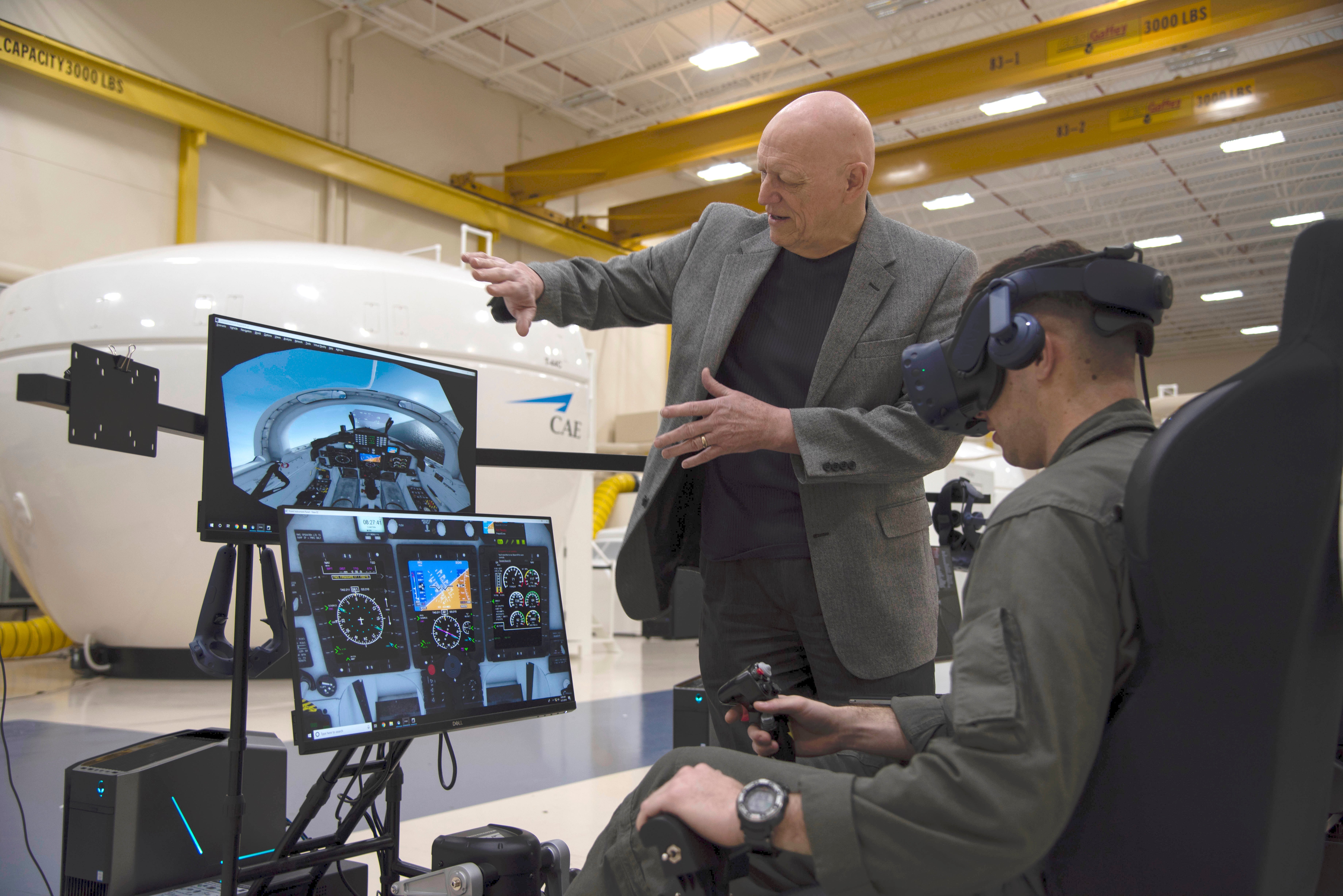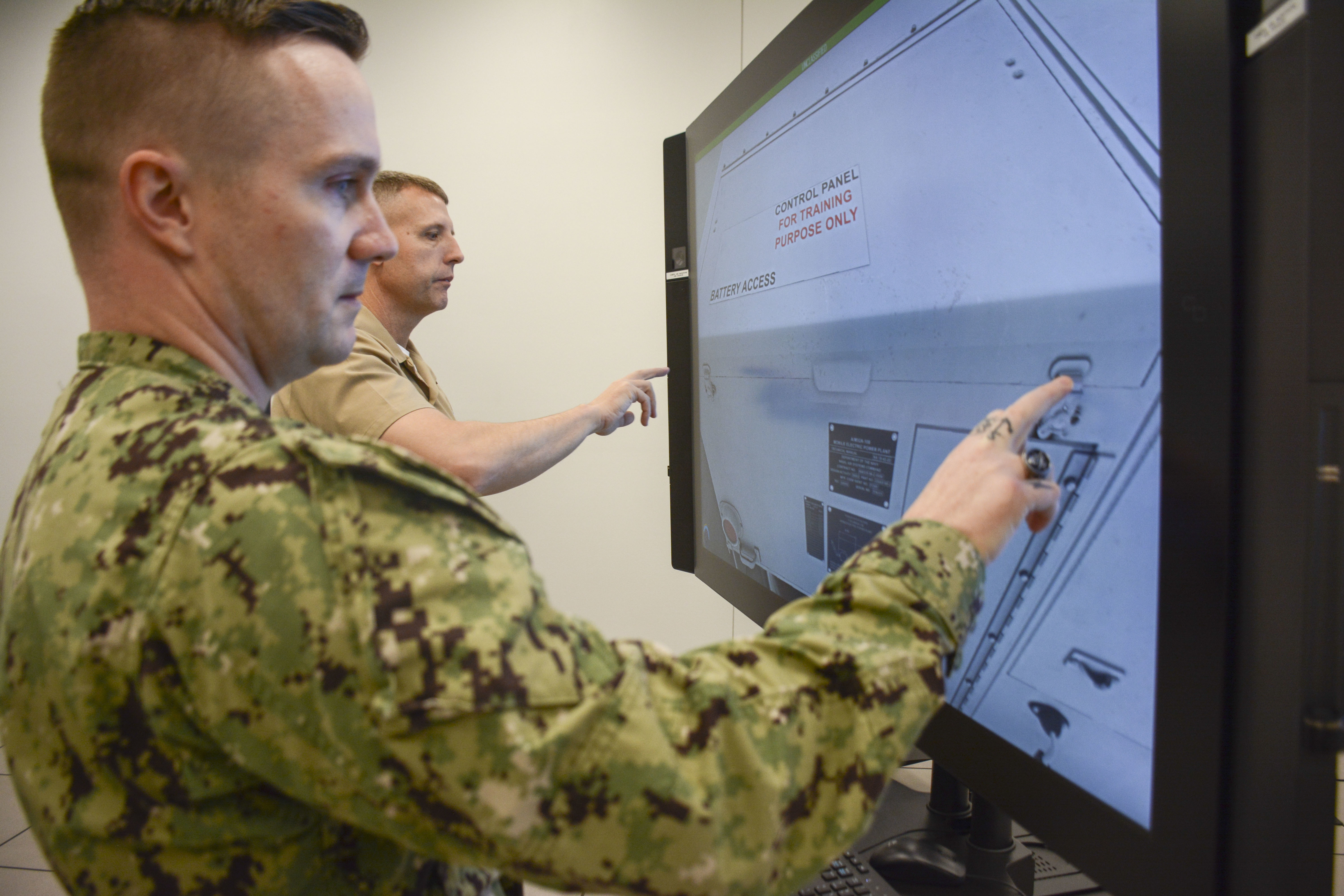
[ad_1]

Wilfred Merkel, simulator requirements officer for Chief of Naval Air Training (CNATRA), provides guidance to 2nd Lt. Liam Wells, a student naval aviator assigned to the “Rangers” of Training Squadron 28, in March 2019. US Navy photo.
The Navy is incorporating new technologies into its aviation training curriculum, from hand-held devices to full simulators, to better train airmen to fly and fight their aircraft.
Speaking at a panel over the weekend at the Tailhook Association’s online symposium, service officials touted the use of live, virtual and constructive (LVC) training and said the Navy is working to embed the methods into its pilot training program.
“We are undergoing modernization across the board, and one of the key pillars of that is to leverage the new technology that is out there in the market,” Rear Adm. Robert Westendorff, the chief of naval air training (CNATRA), told the panel.
Until recently, the training syllabus for naval aviators had not gone through significant changes in the last few decades, Westendorff noted. But now, as part of its Project Avenger initiative, the service is working to include new technologies, ranging from virtual reality goggles paired with mobile devices to “high-fidelity trainers” meant to simulate how an aircraft flies, into its training efforts.
“We’re leveraging virtual goggles where we can immerse ourselves in 360-degree videos,” Westendorff said.
“Those videos can be watched whether you’re in your hangar space, in the classroom, or you’re at your home residence sitting on your couch. So 24/7 access to those videos. They work with the [virtual reality] goggles, that’s what they’re optimized for. But you can also watch those [videos] with your tablet device or iPhone device, and as you move the tablet around, you can still see 360 degrees as the tablet senses the motion.”
In addition to videos that naval aviators can view at any time, the service is also integrating “virtual or mixed reality training devices” into its curriculum.
“You can use those training devices with two flat screens that they’re installed with, or you put on the VR goggles. And it has a rudimentary stick and throttle,” Westendorff said. “And these virtual trainers – you can get those reps and sets to cement a skillset in your mind.”
The chief of naval air training said pilots will also be able to use “high-fidelity trainers” and the Virtual Mission Training System, which can pipe live targets into the radar on the T-45 Goshawk trainer that naval flight students fly, as part of the increased reliance on LVC training.

Manpower, Personnel, Training and Education (MPT&E) Fleet Master Chief Wes Koshoffer, back, interacts with the Multipurpose Reconfigurable Training System (MRTS) 3D Mobile Electric Power Plant (MEPP) simulator at Naval Air Technical Training Center in January 2019. Aviation Support Equipment Technician 1st Class Randy Miracle, left, gave Koshoffer a demonstration of the virtual training environment as part of Koshoffer’s visit to Pensacola-area training commands. US Navy photo.
CNATRA leads the early stages of naval aviation training, overseeing the training of new pilots and naval flight officers learning to fly for the first time in training aircraft. Tactical training comes later, when officers transition into squadrons that go through training led by the Naval Aviation Warfighting Development Center (NAWDC) at Naval Air Station Fallon in Nevada.
Rear Adm. Rich Brophy, the commander of NAWDC, said he has also adjusted the new syllabus for Air Wing Fallon to include new technology and simulations. The syllabus is now five weeks instead of four and includes 31 simulation events.
“Before anybody flies on the range, they will go in and do a simulator event. In fact, not just one, they’ll actually do two simulator events, where they do it once, they get remediation, they go back out and do it again in the simulator and then they get onto the range,” Brophy said.
The team at Fallon has revised its training strategy to hone in on air-to-air combat in preparation for facing off against a near-peer threat, instead of the ground-focused operations the Navy has been conducting for the last two decades in the Middle East, USNI News previously reported.
Earlier this year, Brophy told USNI news that while 60 to 70 percent of the previous syllabus concentrated on dropping ordnance on ground targets, the new strategy for training is 70 percent air-to-air combat.
During the Tailhook panel, Brophy said the Integrated Training Facility the Navy is building at Fallon will include 70 simulators by the conclusion of next year.
“In fact, the first ones are going in right now. F-35s just went in on Monday. And I got to look at them on Tuesday as we put them together and get all the right classification levels going,” Brophy said.
“We’ll be able to put an entire air wing through it, as well as, it will have five simulators that are for the DDGs,” he said of the 70 simulators. “Along with that, we also are using inject to live, just like [Westendorff] is using down there in CNATRA, we’re starting to use that here in our ranges. So [that’s] a long way of saying live, virtual, constructive – it’s here to stay and we’re integrating it completely into our syllabus.”

Commander of Naval Air Forces Vice Adm. DeWolfe Miller uses a surface-to-air missile launcher simulator at Naval Air Station Fallon, Nev., on Feb. 21, 2018. USNI News photo.
When asked if using more simulators would mean that junior officers fly fewer hours in the cockpit during training, Brophy emphasized the importance of flight time in training the next generation’s pilots for all the aspects of performing missions in wartime, including loading and launching ordnance.
Responding to the same question, Westendorff said while the Navy does not currently plan to cut flight hours, the service could if necessary, and pointed to the length of time it takes to train naval aviators.
“By the time we … have an aviator in his fleet squadron, it’s too long. So we’re looking at every opportunity to reduce that time to train. And there may be reductions in flight time – that’s to be determined,” Westendorff said. “What we won’t compromise on, though, is the capability and the competency of those naval aviators and flight officers that we send off to the fleet. They will be better trained tomorrow than they are today. So, again, as it can experiment, time will tell if it makes sense to reduce flight time, but today the answer is no.”
Westendorff said his command would be collecting data to help understand how the insertion of new technologies into training affects the amount of time students need to become proficient, which will inform future decisions about whether to cut training timelines or not.
“Project Avenger is an experiment. And we’re going to collect the data and we’re going to learn from that. And we’re going to analyze, and we’re going to look at the future syllabus of CNATRA. And it depends,” he said. “It may reduce the flight time in the future, or what it does is it allows us to move those advanced tactics, techniques and procedures that are taught in later stages of CNATRA, the [Fleet Replacement Squadron], or the fleet, and we bring them left.”
Related
[ad_2]
Source link